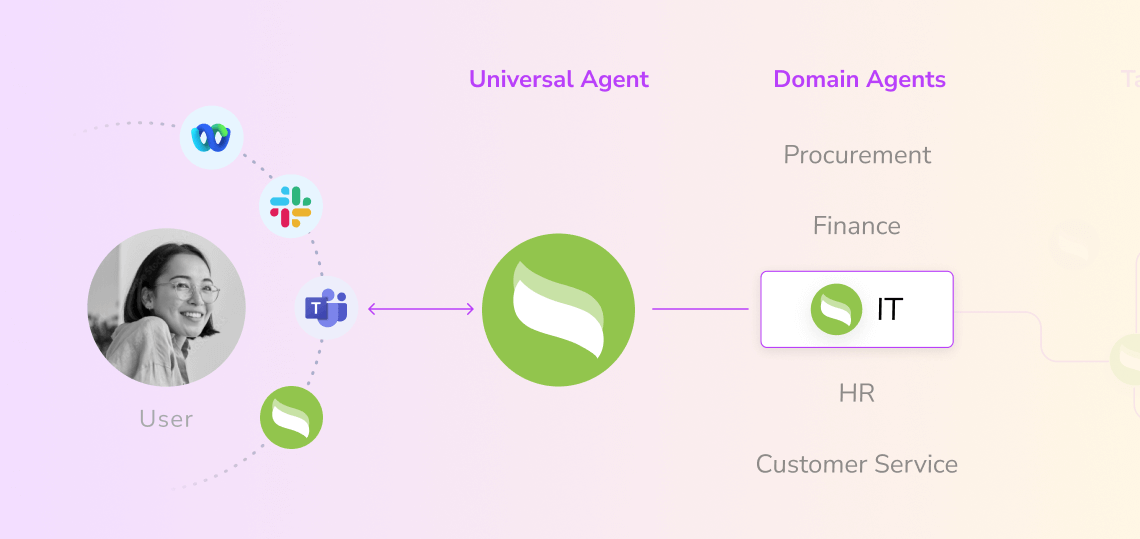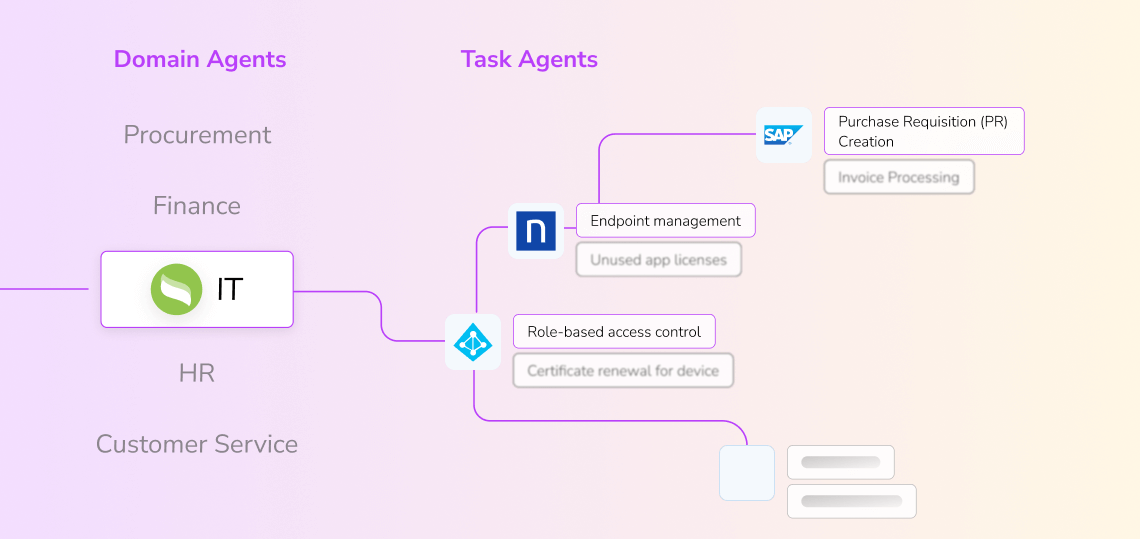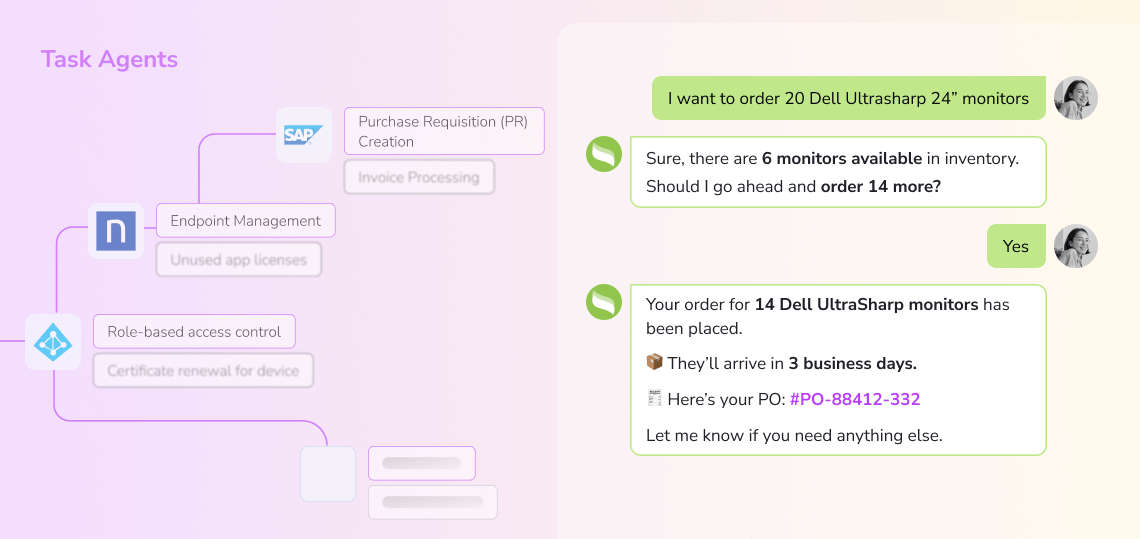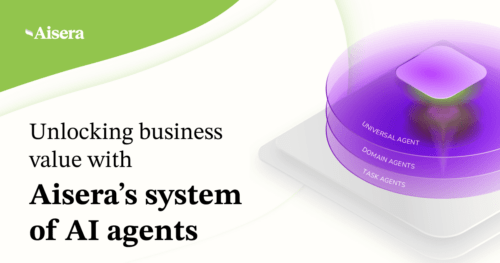Today’s enterprises need more than simple chatbots to function. They need intelligent AI agents who can handle tasks without needing a human to constantly step in. But while AI agents can complete tasks independently, the reality is that most business challenges are interconnected, requiring expert knowledge across multiple domains to tackle challenges that no single agent can address on their own.
At Aisera, we’ve designed our System of AI Agents to drive lasting impact. Our system of AI agents works like a well-coordinated team, where different agents with unique strengths collaborate to solve the complex, multi-faceted problems that businesses actually face. With our system, businesses can scale effectively to meet both the needs of their employees & customers now, as well as the challenges they’ll face in the future. We’ll explore how the system works, its advantages over single-agent systems, and an example of how it would be deployed in the enterprise.
How our System of AI Agents works
Aisera’s system of AI agents works by orchestrating multiple specialized AI agents structured at different levels to solve enterprise problems. Unlike traditional approaches, which route queries through a single agent, our approach harnesses the power of multi agent systems who collaborate and contribute their expertise to solve the problem as a whole. Think of it like consulting a team of experts, where each individual contributes their unique knowledge and strengths to deliver a comprehensive solution. It’s a structure that allows for seamless coordination and improved decision-making, allowing enterprises to scale quickly while boosting efficiency.
Our system of AI agents includes:
- A Universal Agent: Our universal agent acts as the central coordinator that receives the user’s requests, determines which specialized agents to engage, manages their interactions, and generates responses.
- Domain Agents: Domain agents are specialized mid-level agents with expertise in particular business domains or knowledge areas.
- Task Agents: Task agents are specialized agents that perform specific functions like information retrieval, reasoning, or executing particular actions.
- A Communication Protocol: This is a structured format and rules by which agents exchange information, requests, and results. Examples include MCP, Agent2Agent protocol, and ACP.
- Hyperflows: Hyperflows allow you to automate and orchestrate tasks on the fly by calling the right APIs, eliminating the need to pre-define a workflow and enabling rapid request fulfillment.
- Event Studio: Our event studio allows you to build triggers for autonomous actions based on real-time events, helping you solve emerging problems in real time.
Why a System of AI Agents Outperforms Single Agents
Most traditional deployments chase the dream of the “jack-of-all-trades” agent – a singular agent who can handle all aspects of a user interaction. Practically speaking, things are more complicated; business requirements change, or new capabilities are needed, and our system of AI agents offers the ability to be flexible in the face of evolving enterprise needs.
For example, individual agents can be updated, replaced, or added without disrupting the entire system, allowing for increased flexibility. Similarly, domain-specific agents can be maintained independently, and testing and quality assurance can be conducted on individual components. Instead of retraining the entire system, you can keep systems up to date by introducing new agents for a domain.
By delegating tasks to a system of specialized agents, organizations can see improvements in both accuracy and reliability. With domain-specific training and special validation tools, the responses agents generate are more accurate to the domain they represent. AI agents can also use domain-specific integrations and tools to solve more problems. For example, an HR agent can answer an open-ended question like, “What’s our average time to hire this year compared to last year?” by using integrations to Greenhouse or Workday. The result is a system that’s not only flexible but also notably more accurate and reliable for each domain it serves.
Benefits of Aisera’s System of AI Agents
While there are various approaches to structuring a system of AI agents, Aisera’s architecture offers particular advantages when it comes to managing complexity at scale. Our architecture establishes a clear flow of control, one where each agent understands their roles and their limitations.
At the top, our universal agent maintains the overall context and state of the conversation while delegating specific tasks to domain agents below. These domain agents manage their respective workflows and knowledge bases, whether that’s HR policies, financial data, or customer support processes. Meanwhile, at the lowest level are task agents who focus on single, well-defined functions with clear authority boundaries. This distinction is critical as it ensures optimal decision-making and increased accuracy, given that requests are routed to the expert agents equipped to handle the request.
Our system of agents also enables efficient resource allocation and seamless coordination, given that every agent handles their own request. The universal agent can pull in the domain agents it needs help from, which then activates only the required task agents. This, in addition to processing tasks in parallel, reduces the amount of computational resources needed to get the job done, allowing you to scale dynamically with actual demand.
The result is a system that’s not only more organized by design but also one that delivers increased observability. Each level of agents provides natural checkpoints for you to monitor the flow of the request, and problems can be easily isolated to specific agents or interactions. This logical breakdown also makes it easy to spot and treat performance bottlenecks, which not only saves time but also reduces manual effort.
An All-in-One Enterprise Support System
See how our system of AI agents can be implemented to deliver support across an enterprise’s IT, HR, Finance, and Facilities functions.
The Universal Agent

The universal agent serves as the entry point for all user interactions and manages the following responsibilities. While it doesn’t need deep domain knowledge, it still requires a broad understanding to properly route requests.
- Request Classification: Analyzes incoming requests to determine the primary domain(s) required
- Context Management: Maintains conversation history and user context
- Domain Agent Selection: Activates the appropriate domain agents based on request analysis
- Response Synthesis: Combines information from domain agents into coherent responses
- Conflict Resolution: Resolves contradictory information from different domain agents
- Conversation Flow: Manages multi-turn conversations and follow-up questions
The Domain Agents

Each domain agent is an expert in its specific area, rather than trying to spread itself thin across every business function. This specificity means that interactions are more accurate, given that each agent has a solid understanding of the context, terminology, and workflows for their respective domains. For example:
IT Domain Agent
- Handles software, hardware, network, and access-related questions
- Manages IT policy interpretations and applications
- Coordinates with knowledge bases and ticketing systems
- Understands technical jargon, complex documentation, and translates and summarizes it for users
HR Domain Agent
- Addresses personnel policies, benefits, and workplace questions
- Handles sensitive employee information with appropriate privacy controls
- Manages leave requests and organizational structure questions
- Understands HR regulations and company-specific policies
Finance Domain Agent
- Processes expense reports and budgeting questions
- Handles procurement and vendor management queries
- Addresses accounting and financial reporting questions
- Understands financial regulations and company financial policies
Facilities Domain Agent
- Automates access requests and badge creation
- Coordinates room bookings & handles resource management
- Streamlines work order submissions and maintenance requests
- Delivers organization-wide announcements & provides workplace information
Task Agents

Each domain agent coordinates with specialized task agents that handle specific, well-defined operations within that domain. With this division of labor, complex workflows to be broken down into smaller, specific, and more manageable steps that are easier to optimize, test, and maintain. For example:
Knowledge Retrieval Agents
- Search internal knowledge bases
- Retrieve relevant documents and policies
- Maintain version awareness of documents
- Filter information based on user permissions
Workflow Agents
- Initiate and track business processes
- Complete forms and applications
- Generate reports and documentation
- Schedule events and follow-ups
Example Request Flow
Let’s trace a user request through this system:
- User request: “I need to purchase a new laptop for a developer we’re hiring next month.”
- The universal agent breaks down the request:
- Identifies multiple domains: IT (laptop specifications), Finance (purchasing), and HR (new hire)
- Activates all three domain agents
- Establishes priority (IT primary, Finance secondary, HR tertiary)
- The domain agents get to work:
IT Domain Agent:
- Determines laptop specifications for developers
- Activates the knowledge retrieval agent to fetch approved models
- Checks stock availability using its integrations
-
- Finance Domain Agent:
- Checks budget approval requirements
- Activates the workflow agent to prepare the purchase request
- Determines cost center allocation
- HR Domain Agent:
- Confirms new hire status
- Retrieves the onboarding timeline
- Validates equipment allocation policy
- Finance Domain Agent:
- The universal agent collects the information:
- Combines information from all domain agents
- Resolves any conflicts (e.g., IT recommends a model that exceeds Finance budget)
- Generates a comprehensive response
- Determines next steps (e.g., requires user to approve purchase request)
- The universal agent creates a response for the user:
- Presents options with budget considerations
- Outlines the approval process
- Provides a timeline aligned with the new hire’s start date
- Offers to initiate the purchase workflow
Conclusion
The reality of business operations is messy and interconnected. Aisera’s system of AI agents acknowledges this complexity by coordinating a system of specialized agents that deliver collectively superior performance. The result is a more accurate AI with less overhead, one that can actually rise to the challenge when business needs change.
While implementing multi-agent systems does require careful consideration of communication protocols, state management, and security frameworks, the resulting benefits in flexibility, accuracy, and maintainability justify this initial complexity. Our approach gives organizations AI solutions that address today’s needs while creating a solid foundation for continued growth.
Book a custom AI demo to experience the power of Agentic AI in action.


